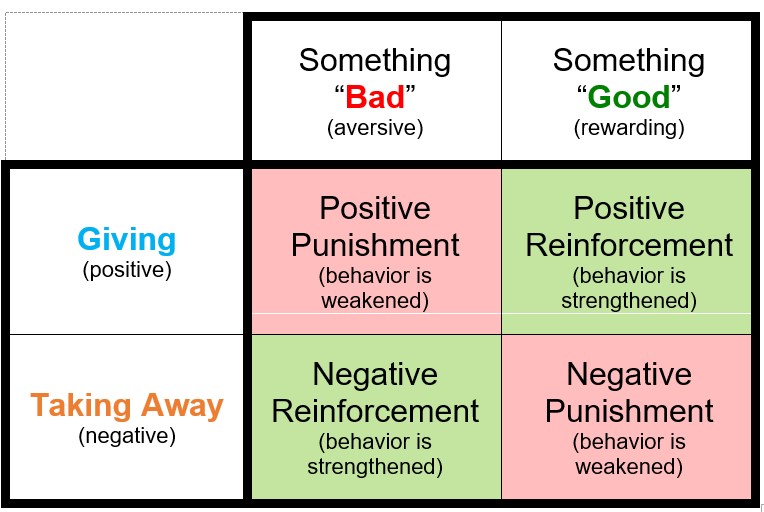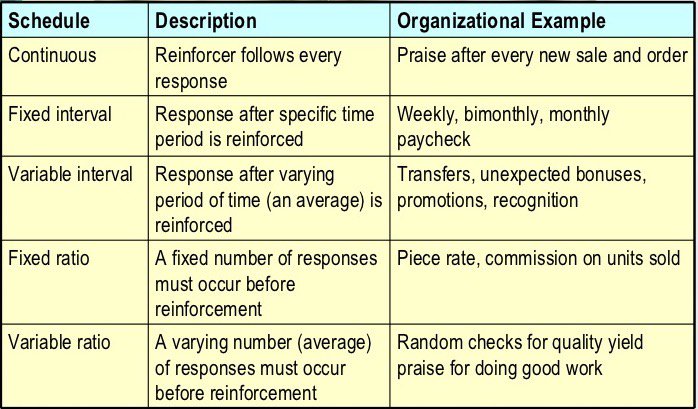- Get link
- X
- Other Apps
- Get link
- X
- Other Apps
Five Operant conditioning procedures are defined by the presentation or removal of a reinforcement or punishment. In this scenario, the term positive is used to imply addition, and negative to denote subtraction of an incentive.
The procedures are:1. Positive reinforcement (Reinforcement): this occurs when a behaviour (response) of the
subject is followed by a stimulus that is rewarding and this increases the
frequency of that behaviour. Positive reinforcement usually is favourable
events given to the subject after portraying a desirable behaviour. In an
experiment involving a rat for instance, a stimulus such as food or a sugar
solution could be delivered when a rat engages in a target behaviour, such as
pressing a lever. Other than food, other forms of positive reinforcement may
include praise, rewards, smile and so on. Positive reinforcement essentially
targets to increase the likelihood of certain behaviours.
2. Negative reinforcement: A negative reinforcer is any stimulus the removal or withdrawal of which increases the likelihood of a particular behaviour. Electric shock, loud noise and so on, are said to be negative reinforcers. Negative reinforcement occurs when a behaviour is followed by the removal of an aversive stimulus, thereby increasing that behaviour’s frequency. This kind of negative reinforcement is called escape. A similar procedure called avoidance occurs when the desired behaviour allows the organism to totally avoid shock, like in the case of exposure to electric shock.
Negative reinforcers typically are characterized by the removal of an
undesired or unpleasant outcome after the desired behaviour. A response is strengthened
as something considered negative is removed. In the Skinner box experiment,
negative reinforcement can be a loud noise continuously sounding inside the
rat's cage until it engages in the target behaviour, such as pressing a lever,
upon which the loud noise is removed.
As noted from the foregoing, reinforcement is a central concept in Behaviourism, and was seen as a central mechanism in the shaping and control of behaviour. A common misconception however, arises that negative reinforcement is synonymous with punishment.
This misconception is rather pervasive. To be clear, while positive reinforcement is the strengthening of behaviour by the application of some event (e.g., praise after some behaviour is performed), negative reinforcement is the strengthening of behaviour by the removal or avoidance of some aversive event (e.g., opening and raising an umbrella over your head on a rainy day is reinforced by the cessation of rain falling on you).
The key
aspect to note in reinforcement is that both types of reinforcement strengthen
behaviour, or increase the probability of a behaviour reoccurring; the
difference is in whether the reinforcing event is something applied (positive
reinforcement) or something removed or avoided (negative reinforcement).
Types of reinforcement
As noted from the foregoing, reinforcement is a central concept in Behaviourism, and was seen as a central mechanism in the shaping and control of behaviour. A common misconception however, arises that negative reinforcement is synonymous with punishment. This misconception is rather pervasive. To be clear, while positive reinforcement is the strengthening of behaviour by the application of some event (e.g., praise after some behaviour is performed), negative reinforcement is the strengthening of behaviour by the removal or avoidance of some aversive event (e.g., opening and raising an umbrella over your head on a rainy day is reinforced by the cessation of rain falling on you).
The key
aspect to note in reinforcement is that both types of reinforcement strengthen
behaviour, or increase the probability of a behaviour reoccurring; the
difference is in whether the reinforcing event is something applied (positive
reinforcement) or something removed or avoided (negative reinforcement).
Schedules of reinforcement
Part of
Skinner's analysis of behaviour involved not only the power of a single
instance of reinforcement, but the effects of particular schedules of
reinforcement over time. Munsaka (2011:11) and Karen, (1975) both identify two
main categories of schedules of reinforcement being continuous and intermittent
reinforcements. These are described in depth below.
Continuous
reinforcement refers to constant delivery of reinforcement for an action; every
time a specific action was performed the subject instantly and always received
reinforcement. This method is impractical to use, and the reinforced behaviour
is prone to extinction.
Under
intermittent reinforcement, we have interval and ratio schedules.
(i)
Interval Schedules
are based on the time intervals between reinforcements. Interval schedules are
further sub divided into:
·
Fixed Interval
Schedule (FI): Here incentives are based on the principle in which
reinforcements are presented at fixed time periods, provided that the
appropriate response is made.
·
Variable Interval
Schedule (VI): An operant conditioning principle in which behaviour is
reinforced based on an average time that has expired since the last
reinforcement.
Both FI and
VI tend to produce slow, methodical responding because the reinforcements
follow a time scale that is independent of how many responses occur.
(ii)
Ratio Schedules: based on the ratio of responses to reinforcements
·
Fixed Ratio Schedule (FR): An operant conditioning principle in which
reinforcement is delivered after a specific number of responses have been made.
·
Variable Ratio Schedule (VR): An operant conditioning principle in which the
delivery of reinforcement is based on a particular average number of responses
(ex. slot machines).
VR
produce slightly higher rates of responding than FR because an organism doesn’t
know when next reinforcement is. The higher the ratio, the higher the response
rate tends to be.
1.
Positive punishment (Punishment)
Simply
put, punishment is the opposite of reinforcement. Weber (1991:72) noted that,
“punishment is any operation that decreases the rate of response. For example,
when a rat presses the lever, shock is presented.” This action will
automatically lead to a decrease in lever pressing, as such, punishment would
have occurred. Positive punishment is sometimes referred to as punishment by
application. When shock or other unpleasant means are instituted to decrease
behaviour, the consequence is referred to as positive punishment. This involves
the presentation of an unfavourable event in order to weaken the response that
follows. Positive punishment is sometimes a confusing term, as it denotes the
"addition" of a stimulus or increase in the intensity of a stimulus
that is aversive (such as spanking or an electric shock).
2.
Negative punishment (Penalty)
This
kind of punishment is associated with the removal of a stimulus, such as taking
away a child's toy or withdrawing a privilege following an undesired behaviour.
This results in a reduction of unwanted behaviour. This procedure is considered
negative because something is removed or taken away from the child (in the case
of a human subject).
3. Extinction:
Occurs when, a behaviour (response) that had previously been reinforced is no
longer effective. For example, a rat is first given food many times for lever
presses. Then, in "extinction", no food is given. Typically, the rat
continues to press more and more slowly and eventually stops, at which time
lever pressing is said to be "extinguished." Extinction may mean the
loss of an acquired response or the failure to make a learned response.
Usually, extinction is brought about when following a period of reinforcement
for responding, reinforcement is no longer offered. We can thus conclude that
the goal of extinction is to curtail or completely eradicate a certain response
action by stopping the provision of a stimulus. This in due course eliminates
certain behaviour.
As noted from the above descriptions on
punishment and extinction, these two have the effect of weakening behaviour, or
decreasing the future probability of a behaviour’s occurrence, by the
application of an aversive stimulus/event (positive punishment or punishment by
contingent stimulation), removal of a desirable stimulus (negative punishment
or punishment by contingent withdrawal), or the absence of a rewarding
stimulus, which causes the behaviour to stop (extinction).
The aim of
punishment and extinction is to weaken the incidences of a particular behaving
reoccurring stimulus/event (positive punishment or punishment by contingent stimulation),
removal of a desirable stimulus (negative punishment or punishment by
contingent withdrawal), or the absence of a rewarding stimulus, which causes
the behaviour to stop (extinction). The aim of punishment and extinction is to
weaken the incidences of a particular behaving reoccurring.


Comments
Post a Comment